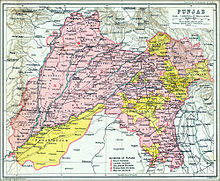
A | B | C | D | E | F | G | H | CH | I | J | K | L | M | N | O | P | Q | R | S | T | U | V | W | X | Y | Z | 0 | 1 | 2 | 3 | 4 | 5 | 6 | 7 | 8 | 9
Chandigarh (/ˌtʃʌndɪˈɡɑːr/) is a union territory and planned city in northern India, serving as the shared capital of the surrounding states, namely Punjab to the north, west and the south, and Haryana to the east. Chandigarh constitutes the bulk of the Chandigarh Capital Region or Greater Chandigarh, which also includes the adjacent satellite cities of Panchkula in Haryana and Mohali in Punjab. It is situated near the foothills of the Himalayas, 260 km (162 miles) north of New Delhi and 229 km (143 miles) southeast of Amritsar.
Chandigarh is one of the earliest planned cities in post independence India and is internationally known for its architecture and urban design.[8] The master plan of the city was prepared by Swiss-French architect Le Corbusier, which built upon earlier plans created by the Polish architect Maciej Nowicki and the American planner Albert Mayer. Most of the government buildings and housing in the city were designed by a team headed by Le Corbusier, Jane Drew and Maxwell Fry. Chandigarh's Capitol Complex—as part of a global ensemble of Corbusier's buildings—was declared a World Heritage Site by UNESCO at the 40th session of the World Heritage Conference in July 2016.[9]
Chandigarh has grown greatly since its initial construction, and has also driven the development of Mohali and Panchkula; the "tri-city" metropolitan area has a combined population of over 1,611,770.[10] The city has one of the highest per capita incomes in the country. The union territory has one of the highest Human Development Index among Indian states and territories.[11] In 2015, a survey by LG Electronics ranked it as the happiest city in India on the happiness index.[12][13][14] In 2015, an article published by BBC named Chandigarh one of the few master-planned cities in the world to have succeeded in terms of combining monumental architecture, cultural growth, and modernisation.[15]
Etymology
The name Chandigarh is a compound of Chandi and Garh. Chandi refers to the Hindu goddess Chandi and Garh means fortress.[16] The name is derived from Chandi Mandir, an ancient temple devoted to Chandi near the city in Panchkula District.[17]
The motif or sobriquet of "The City of Beauty" was derived from the City Beautiful movement, which was a popular philosophy in North American urban planning during the 1890s and 1900s. Architect Albert Mayer, the initial planner of Chandigarh, lamented the American rejection of City Beautiful concepts and declared, "We want to create a beautiful city..."[18] The phrase was used as a logo in official publications in the 1970s and is now how the city describes itself.[19][20]
History

As part of the partition of India in 1947, the former Indian province of Punjab was divided into two parts, the mostly Hindu and Sikh East Punjab in India, and the mostly Muslim West Punjab in Pakistan.[21] The capital of undivided Punjab, Lahore, had become part of Pakistan after the partition. Instead of shifting the capital to an already existing and established city, Jawaharlal Nehru, the first Prime Minister of India, envisioned an altogether new and modern city to be built to serve as the capital of Punjab.[22][23] Partap Singh Kairon, then the Chief Minister of East Punjab, and Edward Nirmal Mangat Rai, then the Chief Secretary of East Punjab, were instrumental in creating Chandigarh as the capital of the state.[24] In 1949, the American planner and architect Albert Mayer was commissioned to design a new city to be called "Chandigarh". The government carved out Chandigarh from about fifty Puadhi-speaking villages in the then-state of East Punjab, India.[25] Shimla was the temporary capital of the state until Chandigarh was completed.
Albert Mayer developed a superblock-based city interspersed with green spaces, with an emphasis on cellular neighbourhoods and traffic segregation. His site plan took advantage of natural land characteristics; the land's gentle grade promoted proper drainage. Mayer stopped his work on the city after his architect-partner Matthew Nowicki died in a plane crash in 1950. Government officials recruited Le Corbusier to succeed Mayer and Nowicki, who utilised many elements of Mayer's original plan without attributing them to him.[26] Le Corbusier designed many administration buildings, including the High Court, the Palace of Assembly, and the Secretariat Building. Le Corbusier also designed the general layout of the city, dividing it into sectors. Chandigarh hosts the largest of Le Corbusier's many Open Hand sculptures, standing 26 metres high. The Open Hand (La Main Ouverte) is a recurring motif in Le Corbusier's architecture, a sign for him of "peace and reconciliation. It is open to give and open to receive." It represents what Le Corbusier called the "Second Machine Age".[9] Two of the six monuments planned in the Capitol Complex which has the High Court, the Assembly, and the Secretariat, remain incomplete. These include Geometric Hill and Martyrs Memorial. Drawings were made, and they were begun in 1956, but they were never completed.[27]
The capital city was officially shifted from Shimla to Chandigarh on 21 September 1953, though Chandigarh was formally inaugurated by India's first president, Rajendra Prasad on 7 October 1953.[28]

During excavations at the time of the building of the city, some Indus Valley artefacts were discovered, suggesting that the area that is today Chandigarh was home to some settlements of the Indus Valley civilisation.[29] On 1 November 1966, after a long-drawn movement demanding the formation of a Punjabi state, the former state of Punjab was split in two. The western and northern mostly Punjabi-speaking portion became the present-day state of Punjab, while the eastern and southern Hindi- and Haryanvi-speaking areas became Haryana. Chandigarh ended up being located on the border of the two states, and both of them moved to incorporate the city into their respective territories. However, the city of Chandigarh was controlled directly by the central government and was to serve as the shared capital of the two states until a resolution could be reached.[30]

Present-day Chandigarh was also the site of a short-lived late 18th-century principality, with a small fort at Mani Majra. As of 2016, many villages that predate the city are still inhabited within the modern blocks of some sectors, including Burail and Attawa, while several other such villages lie on the margins of the city.[31]
Geography

Location
Chandigarh is located by the foothills of the Shivalik Range of the Himalayas in northwest India. It covers an area of approximately 114 km2.[23] It borders the states of Punjab and Haryana. The exact geographic coordinates of Chandigarh are 30°44′N 76°47′E / 30.74°N 76.79°E.[32] It has an average elevation of 321 metres (1053 ft).
The city, lying in the northern plains, includes a vast area of flat, fertile land. Its northeast covers sections of Bhabar, while the remainder of its terrain is part of the Terai.[33] Its surrounding cities are Mohali, New Chandigarh, Patiala, Zirakpur and Rupnagar in Punjab, and Panchkula and Ambala in Haryana.
Chandigarh is situated 44 km (28 miles) north of Ambala, 229 km (143 miles) southeast of Amritsar, and 250 km (156 miles) north of Delhi.
Climate

Chandigarh has a humid subtropical climate (Köppen: Cwa) characterised by a seasonal rhythm: very hot summers, mild winters, unreliable rainfall, and great temperature variation (−1 to 45 °C or 30.2 to 113.0 °F). The average annual rainfall is 1,110.7 millimetres or 43.73 inches.[34] The city also receives occasional winter rains from the Western Disturbance originating over the Mediterranean Sea. The western disturbances bring rain predominantly from mid-December until the end of April, which can be heavier sometimes with strong wind and hail if the weather turns colder (during March–April months), which usually proves disastrous to local crops. Cold winds usually tend to come from the Himalayas that lie to the north, which receive snowfall during wintertime.[citation needed]
The city experiences the following seasons and the respective average temperatures:
- Spring: During spring (from February-end to mid-April), temperatures vary between a maximum of 13 to 20 °C or 55.4 to 68.0 °F and a minimum of 5 to 12 °C or 41.0 to 53.6 °F.
- Autumn: In autumn (from September-end to mid-November), the temperature may rise to a maximum of 30 °C or 86 °F. Temperatures usually remain between 10 and 22 °C or 50.0 and 71.6 °F in autumn. The minimum temperature is around 6 °C or 42.8 °F.
- Summer: The temperature in summer (from mid-April to mid-June) usually peaks at around 43 °C or 109.4 °F in mid-June, and generally varies between 38 and 42 °C (100.4 and 107.6 °F).
- Monsoon: During the monsoon season (from mid-June to mid-September), Chandigarh receives moderate to heavy rainfall and sometimes heavy to very heavy rainfall (generally during August or September). Usually, the rain-bearing monsoon winds blow from the southwest/southeast. The city mostly receives heavy rain from the south (which is mainly persistent rain), but it generally receives most of its rain during the monsoon season either from the northwest or the northeast. The maximum amount of rain received by the city of Chandigarh during the monsoon season is 195.5 millimetres or 7.70 inches in a single day.
- Winter: Winters (November-end to February-end) are mild but can get chilly during peak winter weeks. Average temperatures in the winter generally fluctuate between a maximum of 5 to 14 °C or 41.0 to 57.2 °F and a minimum of −1 to 5 °C or 30.2 to 41.0 °F. Rain usually comes from the west during winter, and it rains for 2–3 days, sometimes with hailstorms.
| Month | Jan | Feb | Mar | Apr | May | Jun | Jul | Aug | Sep | Oct | Nov | Dec | Year |
|---|---|---|---|---|---|---|---|---|---|---|---|---|---|
| Record high °C (°F) | 27.7 (81.9) |
32.8 (91.0) |
37.8 (100.0) |
42.6 (108.7) |
46.0 (114.8) |
45.3 (113.5) |
42.0 (107.6) |
39.0 (102.2) |
37.5 (99.5) |
37.0 (98.6) |
34.0 (93.2) |
28.5 (83.3) |
46.0 (114.8) |
| Mean daily maximum °C (°F) | 18.2 (64.8) |
22.6 (72.7) |
28.0 (82.4) |
34.6 (94.3) |
38.6 (101.5) |
37.7 (99.9) |
34.1 (93.4) |
33.2 (91.8) |
32.9 (91.2) |
32.0 (89.6) |
27.0 (80.6) |
22.1 (71.8) |
29.9 (85.8) |
| Mean daily minimum °C (°F) | 7.2 (45.0) |
10.4 (50.7) |
14.7 (58.5) |
20.3 (68.5) |
24.7 (76.5) |
26.7 (80.1) |
26.9 (80.4) |
26.2 (79.2) |
24.4 (75.9) |
18.4 (65.1) |
12.3 (54.1) |
8.0 (46.4) |
18.2 (64.8) |
| Record low °C (°F) | 0.0 (32.0) |
0.0 (32.0) |
4.2 (39.6) |
7.8 (46.0) |
13.4 (56.1) |
14.8 (58.6) |
14.2 (57.6) |
17.2 (63.0) |
14.3 (57.7) |
9.4 (48.9) |
3.7 (38.7) |
0.0 (32.0) |
0.0 (32.0) |
| Average rainfall mm (inches) | 37.8 (1.49) |
37.3 (1.47) |
27.4 (1.08) |
17.5 (0.69) |
26.8 (1.06) |
146.7 (5.78) |
275.6 (10.85) |
273.0 (10.75) |
154.6 (6.09) |
14.2 (0.56) |
5.2 (0.20) |
22.3 (0.88) |
1,038.4 (40.88) |
| Average rainy days | 2.3 | 3.0 | 2.2 | 1.9 | 2.2 | 6.5 | 9.8 | 11.1 | 6.0 | 0.8 | 0.5 | 1.3 | 47.5 |
| Average relative humidity (%) (at 17:30 IST) | 47 | 42 | 34 | 23 | 23 | 39 | 62 | 70 | 59 | 40 | 40 | 46 | 44 |
| Source: India Meteorological Department[35] | |||||||||||||
Wildlife and biodiversity
Most of Chandigarh is covered by dense banyan and eucalyptus plantations. Ashoka, cassia, mulberry and other trees flourish in the forested ecosystem.[37] The city has forests surrounding itself that sustain many animal and plant species.[38] Deer, sambars, barking deer, parrots, woodpeckers, and peacocks inhabit the protected forests. Sukhna Lake hosts a variety of ducks and geese and attracts migratory birds from parts of Siberia and Japan in the winter season. The Parrot Bird Sanctuary Chandigarh provides a home to a large number of parrots. Sukhna Wildlife Sanctuary was declared a wildlife sanctuary in 1998.
-
Junglefowl, Sukhna wildlife sanctuary, Chandigarh
-
Sambar deer in City Forest Park, Chandigarh
-
Parakeets at the Parrot Bird Sanctuary
-
Nilgai, Dhanas lake, ChandigarhZdroj:https://en.wikipedia.org?pojem=Chandigarh,_India
Text je dostupný za podmienok Creative Commons Attribution/Share-Alike License 3.0 Unported; prípadne za ďalších podmienok. Podrobnejšie informácie nájdete na stránke Podmienky použitia.
Antropológia
Aplikované vedy
Bibliometria
Dejiny vedy
Encyklopédie
Filozofia vedy
Forenzné vedy
Humanitné vedy
Knižničná veda
Kryogenika
Kryptológia
Kulturológia
Literárna veda
Medzidisciplinárne oblasti
Metódy kvantitatívnej analýzy
Metavedy
Metodika
Text je dostupný za podmienok Creative
Commons Attribution/Share-Alike License 3.0 Unported; prípadne za ďalších
podmienok.
Podrobnejšie informácie nájdete na stránke Podmienky
použitia.
www.astronomia.sk | www.biologia.sk | www.botanika.sk | www.dejiny.sk | www.economy.sk | www.elektrotechnika.sk | www.estetika.sk | www.farmakologia.sk | www.filozofia.sk | Fyzika | www.futurologia.sk | www.genetika.sk | www.chemia.sk | www.lingvistika.sk | www.politologia.sk | www.psychologia.sk | www.sexuologia.sk | www.sociologia.sk | www.veda.sk I www.zoologia.sk













